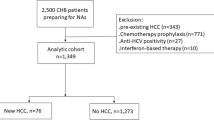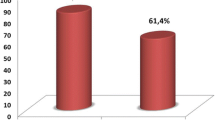Abstract
Background
Human T-lymphotropic virus type 1 (HTLV-1) may worsen the clinical course of hepatitis C virus (HCV) infection. The aim of this study was to investigate whether HTLV-1 coinfection influences the clinical characteristics of patients with HCV infection.
Methods
This retrospective study included 523 consecutive patients from January 2001 to December 2010 with chronic liver disease due to HCV infection, in whom serum anti-HTLV-1 antibodies were examined. Among these patients, 265 were diagnosed with hepatocellular carcinoma (HCC).
Results
The seroprevalence of anti-HTLV-1 antibodies was significantly higher in patients with HCC (21.1 %) than those without HCC (10.5 %, P = 0.001). This significant difference was observed in female patients (29.5 vs. 8.5 %, P < 0.001), but not in male patients (16.5 vs. 12.9 %, P = 0.501). In multivariate analysis, anti-HTLV-1 antibody positivity was independently associated with HCC in female patients [odds ratio (OR), 5.029; 95 % confidence interval (95 % CI), 1.760–14.369; P = 0.003], in addition to age (≥65 years; OR, 10.297; 95 % CI, 4.322–24.533; P < 0.001), platelet count (<15 × 104/μL; OR, 2.715; 95 % CI, 1.050–7.017; P = 0.039), total bilirubin (≥1 mg/dL; OR, 3.155; 95 % CI, 1.365–7.292; P = 0.007), and total cholesterol (≤160 mg/dL; OR, 2.916; 95 % CI, 1.341–6.342; P = 0.007). In contrast, HTLV-1 coinfection was not associated with HCC in male patients, although age, alcohol consumption, platelet count, and albumin were independently associated with HCC.
Conclusions
HTLV-1 coinfection may contribute to the development of HCC in patients with chronic HCV infection, especially in females.


Similar content being viewed by others
References
Thomas DL, Seeff LB. Natural history of hepatitis C. Clin Liver Dis. 2005;9:383–98.
Strader DB, Seeff LB. The natural history of chronic hepatitis C infection. Eur J Gastroenterol Hepatol. 1996;8:324–8.
Seeff LB, Hoofnagle JH. National Institutes of Health Consensus Development Conference: management of hepatitis C: 2002. Hepatology. 2002;36:S1–2.
Seeff LB. Natural history of chronic hepatitis C. Hepatology. 2002;36:S35–46.
Liang TJ, Rehermann B, Seeff LB, et al. Pathogenesis, natural history, treatment, and prevention of hepatitis C. Ann Intern Med. 2000;132:296–305.
Fattovich G, Giustina G, Degos F, et al. Morbidity and mortality in compensated cirrhosis type C: a retrospective follow-up study of 384 patients. Gastroenterology. 1997;112:463–72.
Serfaty L, Aumaitre H, Chazouilleres O, et al. Determinants of outcome of compensated hepatitis C virus-related cirrhosis. Hepatology. 1998;27:1435–40.
Gordon SC, Bayati N, Silverman AL. Clinical outcome of hepatitis C as a function of mode of transmission. Hepatology. 1998;28:562–7.
Degos F, Christidis C, Ganne-Carrie N, et al. Hepatitis C virus related cirrhosis: time to occurrence of hepatocellular carcinoma and death. Gut. 2000;47:131–6.
El-Serag HB. Epidemiology of viral hepatitis and hepatocellular carcinoma. Gastroenterology. 2012;142:1264–73.
Walter SR, Thein HH, Gidding HF, et al. Risk factors for hepatocellular carcinoma in a cohort infected with hepatitis B or C. J Gastroenterol Hepatol. 2011;26:1757–64.
Chuang SC, Lee YC, Hashibe M, et al. Interaction between cigarette smoking and hepatitis B and C virus infection on the risk of liver cancer: a meta-analysis. Cancer Epidemiol Biomarkers Prev. 2010;19:1261–8.
Suruki R, Hayashi K, Kusumoto K, et al. Alanine aminotransferase level as a predictor of hepatitis C virus-associated hepatocellular carcinoma incidence in a community-based population in Japan. Int J Cancer. 2006;119:192–5.
Tokudome S, Tokunaga O, Shimamoto Y, et al. Incidence of adult T-cell leukemia/lymphoma among human T-lymphotropic virus type I carriers in Saga, Japan. Cancer Res. 1989;49:226–8.
Arisawa K, Soda M, Endo S, et al. Evaluation of adult T-cell leukemia/lymphoma incidence and its impact on non-Hodgkin lymphoma incidence in southwestern Japan. Int J Cancer. 2000;85:319–24.
Kondo T, Kono H, Miyamoto N, et al. Age- and sex-specific cumulative rate and risk of ATLL for HTLV-I carriers. Int J Cancer. 1989;43:1061–4.
Gessain A, Barin F, Vernant JC, et al. Antibodies to human T-lymphotropic virus type-I in patients with tropical spastic paraparesis. Lancet. 1985;2:407–10.
Osame M, Usuku K, Izumo S, et al. HTLV-I associated myelopathy, a new clinical entity. Lancet. 1986;1:1031–2.
Yamaguchi K. Human T-lymphotropic virus type I in Japan. Lancet. 1994;343:213–6.
Mochizuki M, Tajima K, Watanabe T, et al. Human T lymphotropic virus type 1 uveitis. Br J Ophthalmol. 1994;78:149–54.
Yoshida M, Seiki M, Yamaguchi K, et al. Monoclonal integration of human T-cell leukemia provirus in all primary tumors of adult T-cell leukemia suggests causative role of human T-cell leukemia virus in the disease. Proc Natl Acad Sci USA. 1984;81:2534–7.
Takeda S, Maeda M, Morikawa S, et al. Genetic and epigenetic inactivation of tax gene in adult T-cell leukemia cells. Int J Cancer. 2004;109:559–67.
Nakashima K, Hayashi J, Hirata M, et al. Hepatitis C virus infection on Iki Island, Japan, an area endemic for human T-lymphotropic virus type-I. A preliminary study in patients at clinics or hospitals. J Epidemiol. 1994;4:17–23.
Benhamou Y, Bochet M, Di Martino V, et al. Liver fibrosis progression in human immunodeficiency virus and hepatitis C virus coinfected patients. The Multivirc Group. Hepatology. 1999;30:1054–8.
Graham CS, Baden LR, Yu E, et al. Influence of human immunodeficiency virus infection on the course of hepatitis C virus infection: a meta-analysis. Clin Infect Dis. 2001;33:562–9.
Hayashi K, Fukuda Y, Nakano I, et al. Poor response to interferon treatment for chronic hepatitis C in human immunodeficiency virus-infected haemophiliacs. Haemophilia. 2000;6:677–81.
Sauleda S, Juarez A, Esteban JI, et al. Interferon and ribavirin combination therapy for chronic hepatitis C in human immunodeficiency virus-infected patients with congenital coagulation disorders. Hepatology. 2001;34:1035–40.
Kishihara Y, Furusyo N, Kashiwagi K, et al. Human T lymphotropic virus type 1 infection influences hepatitis C virus clearance. J Infect Dis. 2001;184:1114–9.
Ichida F, Tsuji T, Omata M, et al. New Inuyama classification; new criteria for histological assessment of chronic hepatitis. Int Hepatol Commun. 1996;6:112–9.
Okayama A, Maruyama T, Tachibana N, et al. Increased prevalence of HTLV-I infection in patients with hepatocellular carcinoma associated with hepatitis C virus. Jpn J Cancer Res. 1995;86:1–4.
Stuver SO, Okayama A, Tachibana N, et al. HCV infection and liver cancer mortality in a Japanese population with HTLV-I. Int J Cancer. 1996;67:35–7.
Boschi-Pinto C, Stuver S, Okayama A, et al. A follow-up study of morbidity and mortality associated with hepatitis C virus infection and its interaction with human T lymphotropic virus type I in Miyazaki. Japan. J Infect Dis. 2000;181:35–41.
Mueller N, Okayama A, Stuver S, et al. Findings from the Miyazaki Cohort Study. J Acquir Immune Defic Syndr Hum Retrovirol. 1996;13:2–7.
Stuver SO, Tachibana N, Okayama A, et al. Heterosexual transmission of human T cell leukemia/lymphoma virus type I among married couples in southwestern Japan: an initial report from the Miyazaki Cohort Study. J Infect Dis. 1993;167:57–65.
Arisawa K, Soda M, Akahoshi M, et al. Human T-cell lymphotropic virus type-1 infection and risk of cancer: 15.4 year longitudinal study among atomic bomb survivors in Nagasaki, Japan. Cancer Sci. 2006;97:535–9.
Shembade N, Harhaj EW. Role of post-translational modifications of HTLV-1 Tax in NF-kappaB activation. World J Biol Chem. 2010;1:13–20.
Nagai M, Brennan MB, Sakai JA, et al. CD8(+) T cells are an in vivo reservoir for human T-cell lymphotropic virus type I. Blood. 2001;98:1858–61.
Welles SL, Tachibana N, Okayama A, et al. Decreased reactivity to PPD among HTLV-I carriers in relation to virus and hematologic status. Int J Cancer. 1994;56:337–40.
Hishizawa M, Imada K, Kitawaki T, et al. Depletion and impaired interferon-alpha-producing capacity of blood plasmacytoid dendritic cells in human T-cell leukaemia virus type I-infected individuals. Br J Haematol. 2004;125:568–75.
Soguero C, Joo M, Chianese-Bullock KA, et al. Hepatitis C virus core protein leads to immune suppression and liver damage in a transgenic murine model. J Virol. 2002;76:9345–54.
Yonkers NL, Rodriguez B, Milkovich KA, et al. TLR ligand-dependent activation of naive CD4 T cells by plasmacytoid dendritic cells is impaired in hepatitis C virus infection. J Immunol. 2007;178:4436–44.
Zhang J, Yamada O, Kawagishi K, et al. Up-regulation of hepatitis C virus replication by human T cell leukemia virus type I-encoded Tax protein. Virology. 2007;369:198–205.
Ioannou GN, Bryson CL, Weiss NS, et al. The prevalence of cirrhosis and hepatocellular carcinoma in patients with human immunodeficiency virus infection. Hepatology. 2013;57:249–57.
Karp DR, Shimooku K, Lipsky PE. Expression of gamma-glutamyl transpeptidase protects ramos B cells from oxidation-induced cell death. J Biol Chem. 2001;276:3798–804.
Ikeda K, Saitoh S, Suzuki Y, et al. Disease progression and hepatocellular carcinogenesis in patients with chronic viral hepatitis: a prospective observation of 2215 patients. J Hepatol. 1998;28:930–8.
Takahashi M, Higuchi M, Makokha GN, et al. HTLV-1 Tax oncoprotein stimulates ROS production and apoptosis in T cells by interacting with USP10. Blood. 2013;122:715–25.
Akuta N, Suzuki F, Seko Y, et al. Complicated relationships of amino acid substitution in hepatitis C virus core region and IL28B genotype influencing hepatocarcinogenesis. Hepatology. 2012;56:2134–41.
Kobayashi M, Suzuki F, Akuta N, et al. Association of two polymorphisms of the IL28B gene with viral factors and treatment response in 1,518 patients infected with hepatitis C virus. J Gastroenterol. 2012;47:596–605.
Uto H, Stuver SO, Hayashi K, et al. Increased rate of death related to presence of viremia among hepatitis C virus antibody-positive subjects in a community-based cohort study. Hepatology. 2009;50:393–9.
Hanaoka M, Kubo T, Saitoh A. Discrepancy between human T-cell lymphotropic virus type I screening test and confirmatory tests in non-endemic areas. J Obstet Gynaecol Res. 2012;38:793–6.
Meytes D, Schochat B, Lee H, et al. Serological and molecular survey for HTLV-I infection in a high-risk Middle Eastern group. Lancet. 1990;336:1533–5.
Conflict of interest
H. Tsubouchi holds endowed faculty positions in research for HGF tissue repair and regenerative medicine, and has received funds from Eisai Co., Ltd. The other authors declare that they have no conflict of interest.
Author information
Authors and Affiliations
Corresponding author
Rights and permissions
About this article
Cite this article
Tokunaga, M., Uto, H., Oda, K. et al. Influence of human T-lymphotropic virus type 1 coinfection on the development of hepatocellular carcinoma in patients with hepatitis C virus infection. J Gastroenterol 49, 1567–1577 (2014). https://doi.org/10.1007/s00535-013-0928-5
Received:
Accepted:
Published:
Issue Date:
DOI: https://doi.org/10.1007/s00535-013-0928-5




